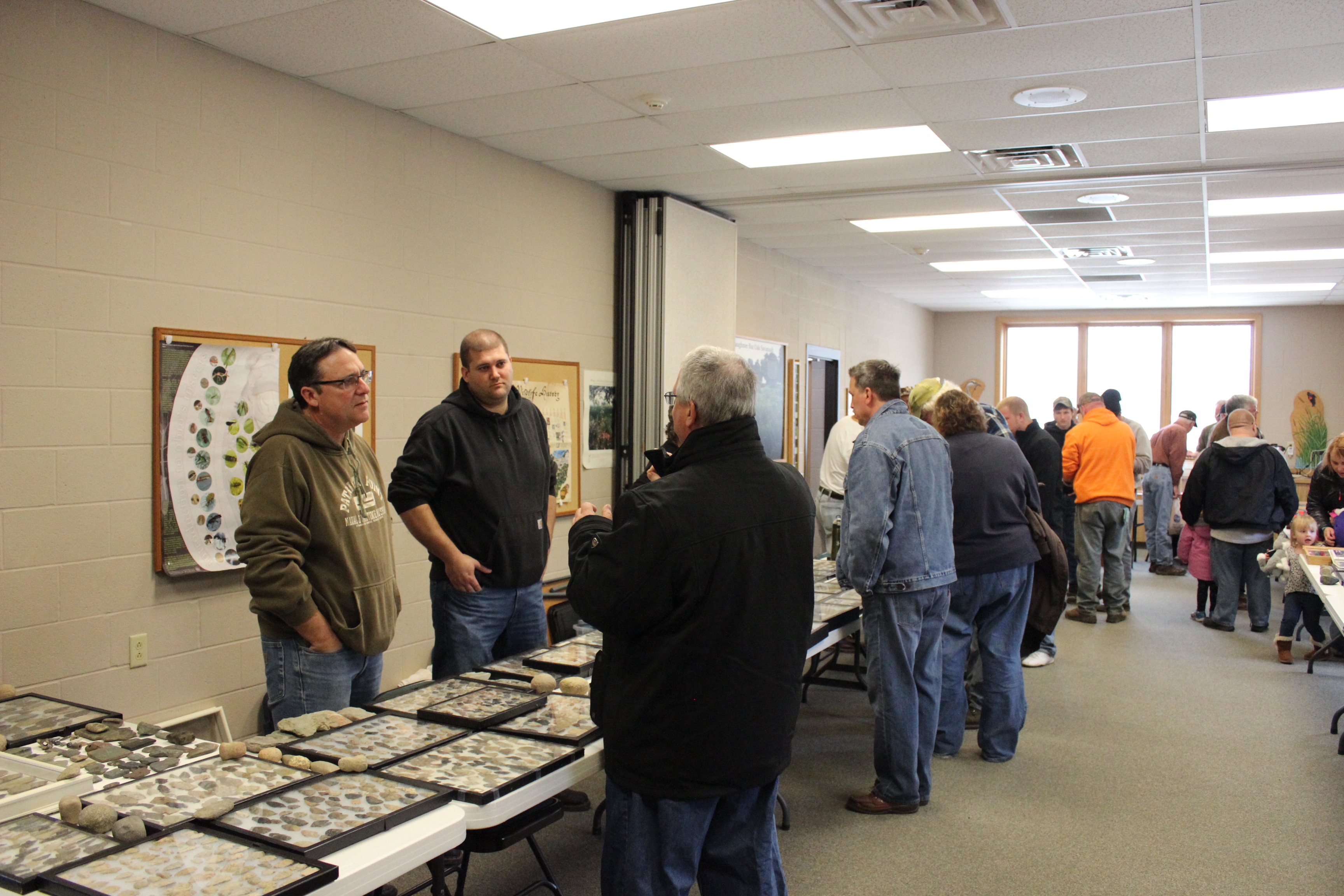By Bob Strohm
bstrohm@wbcowqel.com
Celebrating the tools that the original inhabitants of Crawford County used for their everyday lives, the Crawford Park District held its annual Arrowhead Day at the Lowe-Volk Park Nature Center Saturday.
From 9 a.m. until 2 p.m. arrowhead hunters showed off the collections that they not only found themselves, but were also on hand to verify artifacts brought in by visitors to the program. Visiting Arrowhead Day with her mom Jenny and sister Abby was Sara Holt. Holt had brought an artifact that she had found. Holt spoke about her pendant.
“I found an Indian artifact. I went to my grandma and grandpa’s house and I found it along the fence row. They didn’t know what it was. I went to my Uncle Todd’s across the street, who collects those types of things, and he told me what it was,” Holt said.

In the front room of the Nature Center Tom Wolfe displayed his arrowhead collection found in Crawford County. Wolfe explained one of his favorite pieces that he found.
“I found Clovis point (from) about 12,000 B.C. The Paleo Indians, they used to hunt the mastodons in Ohio, and that is what they would use,” Wolfe said.
Wolfe added that it is important to have permission from landowners before beginning to search for artifacts.
“You can’t just go trampling through a field. It is very, very important if you are searching for arrowheads on someone else’s land to get their permission first,” Wolfe said. “Most of the landowners are very nice people, and will allow you to look for arrowheads, but you have to ask permission first.”
In the back of the Nature Center a flint knapping demonstration was taking place with Jeremy Snyder. Snyder, who began flint knapping in high school and honed his craft in college, spoke of flint knappers and their place in native society while knapping.
“Flint knappers usually lived on the edge of the village because the sharp pieces of stone that would be on the ground from their flint knapping,” Snyder said.
Snyder spoke about the tools that he used compared to those used in older times.
 “Some of the tools I use are the billet. This is a copper tool and it is used to strike down and take off the big flakes off the rock when you get started, and when you do that you want to grind the edge with a braiding stone, that way your tools don’t slip, and you are going to get it down really thin, and when you get it down thin you don’t want to hit it anymore because you are going to break it,” Snyder explained.
“Some of the tools I use are the billet. This is a copper tool and it is used to strike down and take off the big flakes off the rock when you get started, and when you do that you want to grind the edge with a braiding stone, that way your tools don’t slip, and you are going to get it down really thin, and when you get it down thin you don’t want to hit it anymore because you are going to break it,” Snyder explained.
“So you change to a tool called an ishi stick and it is about three foot long, and you are going to push in and down and that is going to sharpen the tool and finish the shaping of it. Then for the notches you are going to use the ishi stick to put those notches in and you just flip it back and forth, taking off little flakes to get the notches.
“In ancient times, they would use deer antler. The antler is lighter weight, and will slip easier. The copper you can dig better, where the antler you have to platform set up better, and you got to hit and press harder. So the antler does work, but it is a lot harder to use,” Snyder continued. “Then the Intrusive Mound Culture and the Hopewell Culture were using copper, and they had copper needles and they were using that as a pressure flaker also. So, depending on the culture they may have used copper in their flint knapping.”
Snyder spoke about the stones used for flint knapping.
“There were other stones used than flint. In Arkansas, they were using Arkansas vermiculite, which will break on the conchoidial fracture, which is what you want to flint knap with,” Snyder noted. “They used petrified wood which will break if it is heat treated correctly. Out West they would use obsidian which is the sharpest material on the Earth. It makes nice knives, and it flakes the easiest, so if you are a beginner knapper obsidian is something nice to work with.”
Organizing the event for the Crawford Park District was Josh Dyer. Dyer explained what went into producing the Arrowhead Day.
“Knowing different collectors who have been finding stuff in Crawford County is definitely nice, because we like to make sure we are showing stuff that people have found here in Crawford County. The Crawford Park District likes to focus on local, so that is a good way to focus on local culture from the prehistoric past here in Crawford County. Having the connections with those people has helped out a lot, and then making sure there is enough table space for everybody,” Dyer said.
For those who can’t get enough of arrowheads, or would like to search for more to add to their collection, the Crawford Park District will be holding their annual arrowhead hunt at 10 a.m. on Saturday, April 8.


